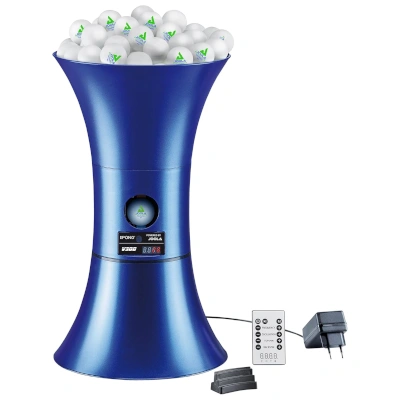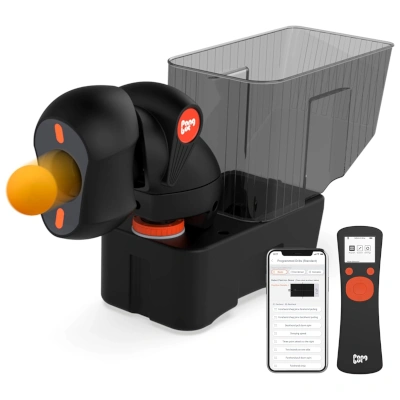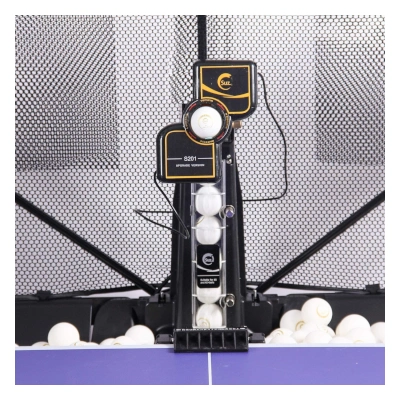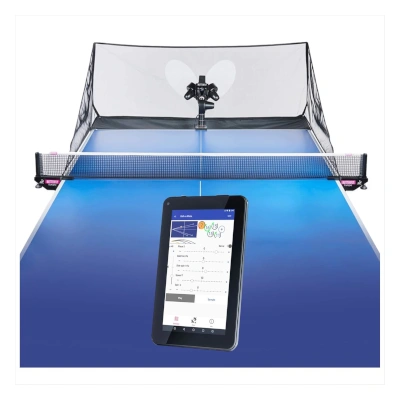Good table tennis robots are perfect for improving technique, reaction time, and footwork – all without the need for a training partner. However, not every model offers the same features. From basic ball delivery to programmable drills and automatic ball retrieval, there are significant differences. In this article, we highlight what to look for and which is the best table tennis robot suiting your playing style.
Best Table Tennis Robots
Joola V300 (TT Buddy)

$118.20
- 20 - 70 BALLS PER MINUTE
- VARIOUS SPINS
- OSCILLATOR FUNCTION
- COMPACT AND LIGHT
- EASY ADJUSTMENT
PONGBOT Nova S Pro

$349.99
- 20 - 85 BALLS PER MINUTE
- PRECISE BALL PLACEMENT
- CUSTOMIZABLE RALLY PATTERNS
- VARIOUS SPINS
- COMPACT AND EASY
Suz S201

$369.99
- 20 - 70 BALLS PER MINUTE
- VARIOUS SPINS
- AUTOMATIC BALL RETRIEVAL
- VERSATILE SPIN TYPES
- QUICK SETUP
Butterfly Amicus Prime

$1,999.99
- 20 - 120 BALLS PER MINUTE
- HIGHLY CUSTOMIZABLE SPIN
- VERSATILE SPINS
- ADVANCED PROGRAMMING
- USER-FRIENDLY
What we cover:
The Best Table Tennis Robots | Our Ranking 2025
Good table tennis robots are specifically designed for players looking to optimize their training at the highest level. With advanced features like variable spin and speed modes, they offer a realistic and challenging training experience. The best table tennis robot allows for targeted practice of specific shots and game strategies, making them a valuable tool for players looking to improve their technique and reaction speed. Thanks to their adaptability, they are particularly well-suited for ambitious players seeking an intense and efficient training session.
Current Price: $118.20
The JOOLA Buddy Pro V300 table tennis robot impresses with variable speed, different spin settings, an oscillator function, and a ball frequency of up to 70 balls per minute, making it ideal for flexible and effective solo training.
- 20 - 70 BALLS PER MINUTE
- VARIOUS SPINS: TOPSPIN, UNDERSPIN, SIDE-SPIN
- OSCILLATOR FUNCTION FOR VERSATILE TRAINING
- COMPACT AND LIGHT FOR EASY HANDLING
- EASY ADJUSTMENT OF BALL FREQUENCY AND SPINS
Ball Speed: Two levels (20 or 70 balls per minute)
Spin Options: Topspin and underspin with two intensity levels each
Oscillator Function: Present
Ball Capacity: Holds up to 100 balls
Weight: Approx. 1.1 Kg
Special Features: Compact design, quick assembly and disassembly, ideal for beginners and hobby players
Joola V300 Review
The JOOLA Buddy Pro V300 stood out in our ranking as an especially user-friendly and versatile training partner and the best table tennis robot in the ranking. Particularly for hobbyists and club players who want to train effectively even without a fixed playing partner, the robot offers a perfect blend of functionality, compactness, and quality at an affordable price.
At the heart of the V300 is its advanced ball–throwing system, which impresses with variable speeds, different spin settings (topspin, backspin, sidespin), and an optional oscillator function. This allows for flexible adjustment of the training level – from simple counter exercises to challenging spin drills. With a ball frequency of up to 70 balls per minute and a capacity of about 100 balls, longer training sessions can be carried out without interruption.
Thanks to its compact and lightweight design, the robot is quick to set up and can be easily transported or stored. Particularly handy: the random function provides varying ball placements, adding more realism to the training. Combined with a catch net (sold separately), the V300 is perfect for solo exercises.
Whether you are a beginner or an advanced recreational player, the JOOLA Buddy Pro V300 table tennis robot offers an impressive price-performance ratio in our review, making structured solo training easy and effective. It is currently available on Amazon for $118.20 – a worthwhile investment for anyone looking to improve their table tennis game without a partner.
Current Price: $349.99
The Pongbot Nova S Pro table tennis robot offers precise ball placement and customizable rally patterns in the comparison, making it perfect for realistic and tailored training scenarios.
- 20 - 85 BALLS PER MINUTE
- PRECISE BALL PLACEMENT FOR TARGETED TRAINING
- CUSTOMIZABLE RALLY PATTERNS
- VARIOUS SPINS: TOPSPIN, UNDERSPIN, SIDE-SPIN
- COMPACT AND EASY TO SET UP
Ball Speed: 11 levels: 30 to 90 balls per minute
Spin Options: 9 types, including topspin, underspin, and sidespin
Control: Via app and remote control
Training Programs: 264 pre-set & custom exercises
Ball Capacity: Up to 150 balls
Weight: Approx. 4 Kg
Special Features: Dual-BASF ball throwing wheels for precise ball delivery; compact design; suitable for all skill levels
PONGBOT Nova S Pro Review
The Pongbot Nova S Pro table tennis robot takes second place in our comparison – and it fully deserves it. It impresses with its modern technology, high precision, and an exceptionally wide range of training programs. This makes it particularly suited for ambitious players looking to specifically improve their technique, reaction time, and footwork.
Best Table Tennis Robot: The control is conveniently done via an app or remote control. Over 260 pre-set training programs are available – from simple spin changes to complex placement exercises. Additionally, individual routines can be programmed, allowing the Nova S Pro to be perfectly tailored to personal training goals.
With up to 90 balls per minute, 9 different spin options, and a highly precise ball dispensing system with two ball wheels, the Nova S Pro provides a realistic and challenging playing experience in our test. The oscillation function for varying ball placements is also included, allowing intense match situations to be simulated. Despite its technical features, this good table tennis robot is compact and easy to set up. It is ideal for home use but also a great asset in a club environment.
For those looking for a smart, powerful device for serious table tennis training, the Pongbot Nova S Pro is the right choice. It is currently available for around $349.99, offering excellent value for money in the upper mid-range.
Current Price: $369.99
The Suz S201 table tennis robot offers adjustable ball speed, frequency, and spin, along with a built-in ball collection net, making it ideal for solo training sessions.
- 20 - 70 BALLS PER MINUTE
- VARIOUS SPINS: TOPSPIN, UNDERSPIN, SIDE-SPIN
- AUTOMATIC BALL RETRIEVAL FOR UNINTERRUPTED TRAINING
- VERSATILE SPIN TYPES FOR REALISTIC TRAINING
- SIMPLE OPERATION AND QUICK SETUP
Ball Speed: 20 to 70 balls per minute
Spin Options: Topspin, underspin, and sidespin
Control: Manual controls, easy to adjust
Training Programs: Adjustable frequency for varied practice
Ball Capacity: Up to 100 balls
Weight: Approx. 2.7 Kg
Special Features: Compact, portable design; ideal for solo practice; quick setup and operation
Suz S201 Review
The Suz S201 table tennis robot stands out as a highly effective and affordable training tool, ideal for hobbyists and club players. It offers an impressive mix of user-friendly features, reliability, and versatility, making it a great choice for anyone looking to elevate their game without a training partner.
Equipped with an advanced ball dispensing system, the S201 allows players to adjust the ball speed and spin (topspin, backspin, sidespin), providing a dynamic range of exercises. Whether you’re fine-tuning your counter-hits or tackling complex spin drills, this robot can cater to your specific training goals. With a ball frequency of up to 70 balls per minute and a 100-ball capacity, it ensures continuous practice without interruptions.
Its compact and lightweight design makes the S201 easy to set up, transport, and store. The oscillation function further enhances training by randomly varying the ball placement, which helps simulate real-match conditions and improves footwork and reaction time. Additionally, the robot comes with a catch net and training balls, making solo training sessions even more convenient.
Perfect for both beginners and intermediate players, the Suz S201 offers excellent value for money, making it an ideal choice for focused, solo practice. Currently available on Amazon for approximately $370, it provides a worthwhile investment for players who want to improve their table tennis skills at their own pace.
Current Price: $1,999.99
The Butterfly Amicus Prime stands out with advanced customization options for spin, speed, and trajectory, offering an unparalleled training experience for serious players.
- 20 - 120 BALLS PER MINUTE
- HIGHLY CUSTOMIZABLE SPIN, SPEED, AND TRAJECTORY SETTINGS
- VERSATILE SPINS (TOPSPIN, UNDERSPIN, SIDE-SPIN)
- ADVANCED PROGRAMMING OPTIONS FOR COMPLEX DRILLS
- USER-FRIENDLY AND QUICK TO ADJUST
Ball Speed: Up to 120 balls per minute
Spin Options: Topspin, underspin, sidespin, and no spin
Control: Wireless via Android tablet (included) or iOS/Android devices
Training Programs: 21 pre-saved drills with video demonstrations; customizable drills
Ball Capacity: Up to 120 balls
Weight: Approx. 6 Kg
Special Features: Bluetooth connectivity, randomization of ball placement and type, interval training mode, mirror function for left/right-handed users, sample function for individual balls
Butterfly Amicus Prime Review
The Butterfly Amicus Prime table tennis tobot is a top-tier training tool designed for serious players looking to elevate their game. With advanced technology, extensive customization options, and an intuitive control system, it’s the best table tennis robot 2025 for athletes who want a challenging, professional training experience.
Amicus Prime stands out with its ability to deliver up to 120 balls per minute, offering a wide range of spin, speed, and placement settings. This allows players to simulate a variety of match scenarios and fine-tune their skills. Whether practicing fast attacks, defensive strokes, or mastering spins like topspin, backspin, and sidespin, this robot adapts to all training needs. Its advanced ball dispensing system ensures precision and consistency, helping players improve their footwork and reaction times.
One of the standout features of the Amicus Prime is the wireless control system, which make this one of the best table tennis robots and can be operated via a user-friendly app pre-installed on an Android tablet (included), or downloaded to any Android or iOS device. The app allows players to create custom training routines and access over 20 pre-programmed exercises, offering a flexible training experience. The robot also includes a service recognition function, enabling the Amicus Prime to simulate real-match conditions by detecting the player’s strokes and adjusting the ball delivery accordingly.
Designed for versatility and ease of use, the Amicus Prime is compact and can be easily set up, making it perfect for both home and club use. The system also includes 120 Butterfly training balls, a ball catch net, a carrying case, and a 3-year warranty for peace of mind.
While it is on the higher end of the price spectrum, retailing for around $2k, the Amicus Prime offers exceptional value for players serious about improving their table tennis skills. With its top-notch features and professional-level performance, it’s a worthwhile investment for those looking to train at the highest level.
General Information About The Best Table Tennis Robots
What's a good table tennis robot?
A table tennis robot is a device designed to assist players during training. It automatically simulates the balls that a human opponent would hit, allowing for individual practice without the need for a training partner.
Key features of a table tennis robot:
- Ball Dispensing: The robot launches balls at regular intervals, which can be returned in various types (e.g., topspin, backspin, sidespin).
- Adjustable Ball Frequency: The frequency of ball dispensing can be adjusted, allowing for training sessions ranging from slower warm-up rounds to fast-paced reaction drills.
- Spin Options: Many models allow the adjustment of different spins, making training more realistic and varied.
- Oscillator Function: Some robots can vary the direction of the balls, requiring the player to move positions, thus enhancing reaction speed and agility.
By using a good table tennis robot, players can effectively improve their technique, reaction time, and shot accuracy without relying on a training partner.
What Types of Table Tennis Robots Are There?
The most popular table tennis robots come in different types, each designed to meet various training needs. Here are the main types:
- Basic Robots: These robots are designed for simple ball dispensing. They are generally more affordable and suitable for beginners or casual players looking to practice their shots. They typically offer basic ball speeds and spin options.
- Advanced Robots: Advanced models come with a range of features, including adjustable ball frequency, multiple spin options (topspin, backspin, sidespin), and the ability to vary the ball placement on the table. These robots are ideal for players looking to improve their technique and skills at a higher level.
- Multi-Function Robots: These robots offer a variety of functions, such as the ability to simulate different types of rallies, change the ball direction (oscillator function), and even simulate a variety of opponents’ playing styles. They are great for players who need a more comprehensive training tool.
- Robots with Ball Catch Nets: Some robots come with a ball catch net that automatically collects balls after each shot, reducing the need to pick them up manually. This is particularly useful for solo practice sessions.
- Professional Robots: High-end robots are designed for high-performance training. They usually feature a wider range of speed, spin, frequency, and placement control. These robots can be programmed for specific drills and are often used by serious players and professional clubs.
Each type of table tennis robot has its advantages, depending on your training goals, skill level, and budget.
Advantages of a table tennis robot
A good table tennis robot offer numerous advantages that greatly enrich and make training more efficient for players of all skill levels. The main benefits include:
- Improvement of Stroke Technique and Footwork: By receiving balls at varying speeds and spins, players can specifically improve their technique and reaction time.
- Continuous and Flexible Training: Robots allow for practice without a training partner, with ball frequency and direction being adjustable. This promotes endurance and ball control.
- Efficient Use of Time: Thanks to automatic ball retrieval systems, such as catch nets, the need to manually collect balls is eliminated. This saves time and enables longer, uninterrupted training sessions.
- Programming Custom Drills: Many robots allow for the creation and storage of specific training sequences, enabling focused work on particular stroke techniques or game situations.
- Increased Training Intensity: With high ball frequency and the ability to adjust various spins, players can effectively train their reaction speed and endurance.
However, it is important to note that the best table tennis robot cannot fully replace a human training partner. The table tennis ball machine serves as a valuable supplement, especially for technical and endurance training, while aspects such as tactical game understanding and reaction to human opponents should continue to be developed through play with real partners.
Disadvantages of a Table Tennis Robot:
Table tennis robots offer numerous benefits for training, such as the ability to precisely repeat stroke techniques and improve footwork. However, there are also some disadvantages to consider when using them.
- Replacement for Human Opponents: Robots cannot fully replicate the reaction time and tactical play of a human opponent. Training with a robot does not replace the experience of competing against real players.
- Lack of Competitive Aspect: Unlike real matches, training with a robot lacks the competitive element, which often helps increase motivation and engagement.
- Maintenance Requirements: Robots require regular maintenance and care to ensure they function properly. This can lead to additional effort and costs.
- Space Requirements: Setting up and storing a table tennis robot requires extra space, which may not always be available.







